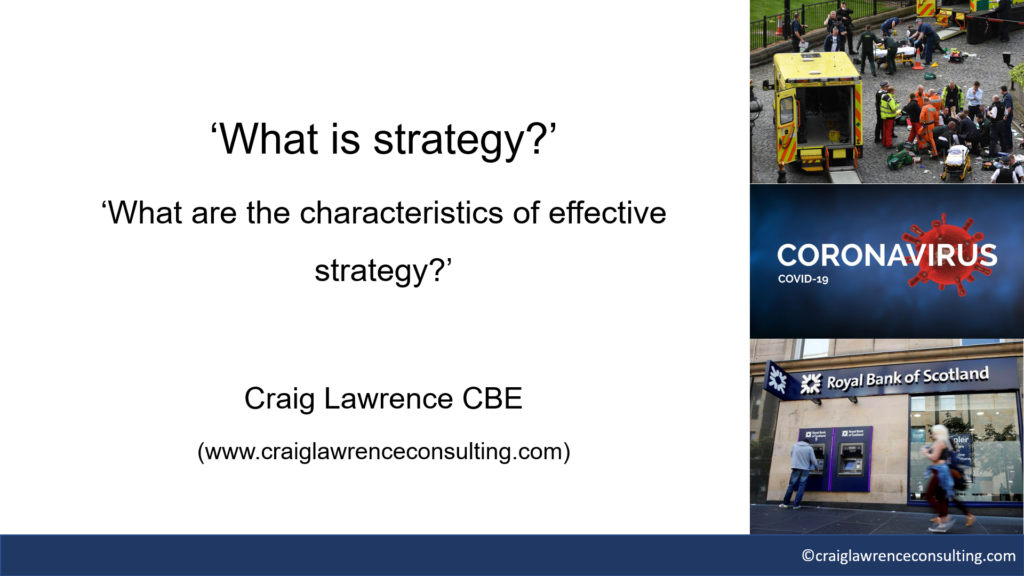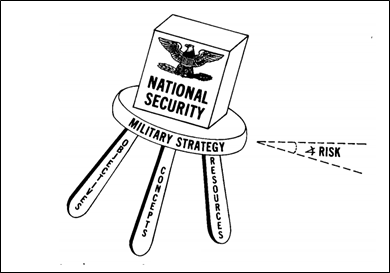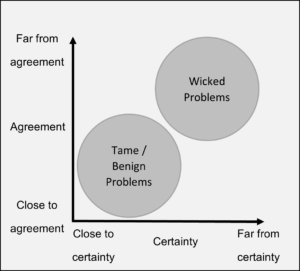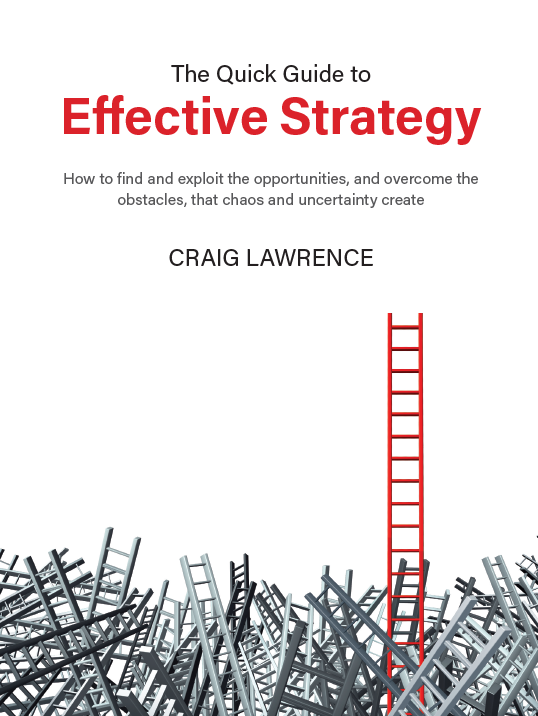What is Strategy?
We believe that a leader’s most important responsibility is getting their organisation’s strategy right – the first step to doing this is understanding what is strategy?
What is strategy?
The article below is effectively an extract from Chapter One of our book ‘The Quick Guide to Effective Strategy’ and is intended to provide an introduction to strategy by answering the question what is strategy? We’ve also produced a short (12 min) presentation that answers the same question and that also considers the defining characteristics of the most effective strategies (as the article does). Click the button below to watch the vid!

An Introduction to strategy and what is strategy?
Strategy has been around for a very long time. Indeed, the word has its origins in classical Greek.[i] But, despite its long history, there’s still a great deal of discussion about what it means and therefore the answer to the question what is strategy? For example, if you Google what is strategy you will get nearly four billion answers.[ii] The problem is that strategy means different things to different people. To some, its synonymous with a high-level plan; to others, it’s just a word you add to other words to make them sound better or more important.
The renowned historian Sir Hew Strachan suggests that ‘the word strategy has acquired a universality which has robbed it of its meaning and left it only with banalities.’[iii] Richard Rumelt, author of the best-selling Good Strategy/Bad Strategy, agrees believing that ‘the word ‘strategy’ has become a verbal tic.’[iv] Even one of the UK House of Commons’ formal committees concluded that ‘the term strategy has been so widely applied, to all sorts of activities, that it has become devoid of real value.’[v]
Sir Lawrence Freedman, arguably the UK’s most esteemed living authority on strategy, acknowledges this unfortunate state of affairs but also notes ‘yet strategy remains the best word we have for expressing attempts to think about actions in advance, in light of our goals and our capacities.’[vi] And this gets at the essence of what real strategy is all about and helps us answer the question what is strategy? In a nutshell, it’s about identifying where you want to be in the future and then working out how you’re going to get there, despite having little real control over how the future will unfold or how other actors will behave.
Arthur Lykke’s ends, ways and means strategy stool and a formulaic answer to the question what is strategy?
In the late 1980’s, Arthur F Lykke, a retired Army colonel working at the US Army War College, suggested that strategy could be expressed as a formula where:
‘Strategy’ = ‘Ends’ + ‘Ways’ + ‘Means’[vii]
Lykke believed that the three components of strategy were like the legs of a stool which, if they were not all in balance, would tilt, creating risk. The original illustration published with the article that explained his view is shown at Diagram 1.

Lykke’s formula has shaped the way many people have viewed strategy – and answered the question what is strategy? – for decades. There is nothing wrong with Lykke’s definition, indeed, at the time he proposed it the Vietnam War was still fresh in the US’ collective memory and it served as a salutary reminder that, unless they were appropriately resourced, the US’s military strategies were highly unlikely to succeed. But the issue I have with Lykke’s definition is that it doesn’t capture the unpredictable ‘future’ aspect very well, if at all. It rather implies that if the ‘ends’, ‘ways’ and ‘means’ are all in balance, then the strategy will most likely succeed. Unfortunately, life is seldom that straightforward as the future has a habit of unfolding in the most unexpected ways. So although it helps us a bit, Lykke’s formula doesn’t really answer the question what is strategy?
Strategy as a blueprint to a desired future and a better answer to the question what is strategy?
Let’s assume you asked the Institute of Directors (IoD), the professional body that represents the interests of business directors in the UK, what is strategy? They would answer that ‘strategy is about determining a direction of travel and also identifying the basic principles by which this direction can be achieved.’[x] This is a useful description because it dispenses with a formula and recognises that strategy is about moving forward into the future in a particular way but it doesn’t explain the destination that the direction of travel is intended to achieve. For that reason, the definition proposed by Harry Yarger, author of the excellent Strategy Theory for the 21st Century: The Little Book on Big Strategy, is more helpful:
‘Strategy provides a coherent blueprint to bridge the gap between the realities of today and a desired future. It is the disciplined calculation of overarching objectives, concepts, and resources within acceptable bounds of risk to create more favourable future outcomes than might otherwise exist if left to chance or the hands of others.’[xi]
As well as being clear about the destination – a ‘desired future’ – Yarger’s definition highlights the point that one of the defining characteristics of strategy is that, because it looks to the future, it operates in a world of uncertainty. This is one of the reasons that strategies are different to plans. As Freedman notes, ‘a plan supposes a sequence of events that allows one to move with confidence from one state of affairs to another.’[xii] In other words, plans operate where there is little uncertainty. He goes on to state that ‘strategy is required when others might frustrate one’s plans because they have different and possibly opposing interests and concerns.’[xiii]
Add in other variables, such as invasions of sovereign states by other sovereign states, global pandemics, recessions, financial crises, sudden spikes in energy prices or interest rates, shock election or referendum results or even giant container ships getting stuck in the Suez Canal and it becomes apparent very quickly that trying to chart a course through the unpredictable turbulence of the future is a tricky business, even if your strategy’s ‘ends’, ‘ways’ and ‘means’ are all in balance.
Strategy and wicked problems – digging beneath what is strategy?
Let’s now assume you asked Richard Rumelt what is strategy? He’d likely answer that ‘a strategy is a way through a difficulty, an approach to overcoming an obstacle, a response to a challenge.’[xiv] This pragmatic approach encourages clarity of purpose, which is a another defining characteristic of effective strategies, but the difficulty is the nature of the obstacles or challenges that most strategies are required to address. To understand this better, it helps to step back in time nearly half a century to 1973. In June of that year, Horst Rittel and Melvin Webber, two professors at the University of California, published a ground-breaking paper that differentiated between ‘tame’ or ‘benign’ problems and what they called ‘wicked’ problems.[xv] Their proposition was that societal problems were ‘inherently different from the problems that scientists and perhaps some classes of engineers deal with.’[xvi]
Rittel and Webber argued that these problems, such as solving a mathematical equation or analysing the structure of an unknown chemical compound, were ‘tame’ because, although they might be complicated and technically difficult, there is little doubt that a definitive solution exists and it’s clear when the problem has been solved. Other problems, such as confronting crime or addressing poverty are ‘wicked’ because there is a high degree of uncertainty about both the nature of the problem and the solution.
The uncertainty might be because the problem is difficult to define or because the relationship between cause and effect is hard to discern.[xvii] What this means in practice is that when an action is applied to try to treat the problem, there is likely to be an unintended consequence somewhere else. Keith Grint, one of the foremost experts in the analysis and resolution of contemporary problems, believes ‘this is typical of what happens when we try to solve wicked problems – other problems emerge to compound the original problem.’[xviii] The uncertainty might even be because a definitive solution does not actually exist and the best we can hope for is to identify a range of measures that might improve the situation, rather than resolve it outright.
Examples of wicked problems – and why this understanding helps us answer the question what is strategy?
The UK economy is a good topical example of a wicked problem. Although we expect political parties to have different views on the most effective way of stabilising the economy and stimulating growth, expert economists also disagree on the best approach. Some advocate a return to the fiscal policies of John Maynard Keynes, which include increasing government expenditure and cutting taxes, while others believe such an approach would be catastrophic because the policies could only be funded by increasing national debt at a time when this is already high and the cost of borrowing is more expensive than it has been for over a decade.
Ronald Heifetz, one of the first people to consider how such problems might be addressed, described these sorts of challenges as ‘adaptive’ because they cannot be resolved by good management or technical expertise alone. Instead, their resolution requires innovation and constant learning as the dynamics of the problem change.[xix] A good example of this is the global COVID-19 pandemic. Although national governments adopted different strategies to try to control the spread of the disease and reduce its impact on their domestic populations, what these strategies all had in common was that they continued to be adapted as the different governments learnt more about the virus.
Visualising wicked problems can help us understand what is strategy?
A helpful way of visualising wicked problems is to plot them on a Stacey Matrix, such as that illustrated in Diagram 2. Professor Ralph Stacey, an organisational theorist at the University of Hertfordshire, first published his matrix in 1996 as a way of understanding the factors that contribute to complexity in decision-making. Although not really intended for this purpose, it provides an effective way of highlighting the varied characteristics of Rittel and Webber’s different types of problems.[xx]

Characteristics of wicked problems
Diagram 2 highlights the point that wicked problems are difficult to resolve because there is a high degree of uncertainty and disagreement about both the nature of the problem and the solution. Developing this further, most wicked problems exhibit some, or all, of the following characteristics:
- First, they are difficult to define (both in terms of the nature of the problem and the desired outcome).
- Second, they usually generate disagreement amongst stakeholders (about the nature of the problem, the desired outcome and how the desired outcome should be achieved).
- Third, causal relationships are hard to discern.[xxi] As a result, actions taken to achieve a desired effect are likely to have unintended consequences, which may exacerbate the problem.
- Fourth, often, they don’t have a definitive solution and the best we can hope for is just an improvement in the current situation.
- Fifth, they usually exist in a changing and uncertain environment, often extending well into the future (which nobody can predict with anything like 100% accuracy).
- Sixth, they require constant reappraisal as:
- Our understanding of the problem and the environment improves.
- The situation changes.
- The problem morphs (often as an unintended consequence of our own strategy and/or because of other actors’ actions).
Why strategies need to be adaptable: the value of the ‘big idea’
Strategies are intended to address problems with the above characteristics. And because they seek to shape the future, which is volatile, uncertain, complex and ambiguous (VUCA), strategies need to be highly adaptable by design. This is an important consideration in answering the question what is strategy? The requirement to be adaptable is also a defining characteristic that differentiates them from plans and places a premium on a strategy being underpinned by a ‘big idea’ or ‘guiding policy’.[xxii] This is an innovative approach that turns the strategy into more than the sum of its parts. Rumelt describes it as ‘an insight that, when acted upon, provide[s] a much more effective way to compete – the discovery of hidden power in the situation.’[xxiii] In business, it’s the brilliant insight that knocks the socks off the competition[xxiv] and establishes the company as a leader in its field, whether in overcoming a significant threat that destroys much of the competition (such as COVID-19) or in identifying what Chan Kim and Renée Mauborgne refer to as the blue ocean of a new market that nobody else has thought of before.[xxv]
At the national/political level, Freedman puts it succinctly in describing strategy as being ‘about getting more out of a situation than the starting balance of power would suggest. It is the art of creating power.’[xxvi] This seems particularly apt as a description of the Taliban’s success in Afghanistan. To many, it seemed as if almost out of nowhere they were able to regain control of the country in August 2021 when NATO and its allies left after nearly two decades of fighting. A fundamental aspect of the Taliban’s strategy was that it took account of all the key stakeholders, another defining characteristic of the most effective strategies.
The importance of resilience and creativity in understanding what is strategy?
As well as giving the strategy a ‘magnifying’ ability, the ‘big idea’ enhances the strategy’s resilience. It does this by providing a guiding principle when circumstances change, which they inevitably will, and the strategy needs to be adapted. So having a central ‘big idea’ is another characteristic of effective strategies and this is why creativity is so important in a strategy’s development, where creativity can be defined as ‘making loose, or freeform associations between seemingly unrelated phenomena’[xxvii] or, as British writer and comedian John Cleese prefers, ‘new ways of thinking about things’.[xxviii]
Strategy as a theory of success
Another characteristic that helps us understand what is strategy is that strategies are high level.[xxix] They set out the desired direction of travel of an organisation, or what David Petraeus calls its ‘azimuth’ or path.[xxx] And a final characteristic is that they must provide what Eliot Cohen, one of the giants of international relations theory, describes as a ‘theory of victory’[xxxi] or what Jeffrey Meiser, a US academic at the forefront of strategy development, prefers to call a ‘theory of success’.[xxxii]
Meiser’s view is that defining strategy as a theory of success ‘forces strategists to clarify exactly how they plan to cause the desired endstate to occur.’[xxxiii] This last point is critical: whatever else a strategy does, and notwithstanding the turbulence and uncertainty that lie ahead once it starts being implemented, it must explain how the desired endstate is going to be achieved. With that in mind, it is worth reflecting on this finding from the formal inquiry into Britain’s military intervention in Iraq in 2003 which, the inquiry concluded, ended a ‘very long way from success’:[xxxiv]
‘Crucially, UK strategies tended to focus on describing the desired end state rather than how it would be reached. On none of the 20 occasions when UK strategy was reconsidered was a robust plan for implementation produced. Setting a clear direction of travel is a vital element of an effective strategy, but strategies also require a serious assessment of the material resources available and how they can best be deployed to achieve the desired end state.’[xxxv]
Characteristics of effective strategy
The aim of this short introduction on the nature of strategy is to provide an accessible answer to the question what is strategy? In doing this, it also identifies eight characteristics that define highly effective strategies:
- First, they have clarity of purpose (why a strategy is needed and what its desired endstate is).
- Second, they are designed to operate in volatile, uncertain, complex and ambiguous (VUCA) environments (because the future, which none of us can predict, is likely to be even more turbulent than the present).
- Third, they operate at a high level, determining the direction of travel of an organisation or state.
- Fourth, they are designed to address ‘wicked problems’, where neither the problem nor the solution is easily identified.
- Fifth, they account for all stakeholders, changing their behaviours to create favourable conditions.
- Sixth, they are highly innovative, with a central ‘big idea’ or ‘guiding policy’ that ‘magnifies’ their effect and enhances their resilience.
- Seventh, they provide a ‘theory of success’ (or ‘theory of victory’[xxxvi]) that explains how the desired endstate is to be achieved, rather than just a general approach.
- Eighth, they are highly adaptable (so the strategy can be modified as the situation changes, or when it becomes apparent that assumptions underpinning the strategy’s development were flawed).
Developing effective strategy
This brief explanation of strategy – and answer to the question what is strategy? – is taken from the Quick Guide to Effective Strategy. We use the approach outlined in the book when we work with organisations to help them develop their own winning strategies. The approach to strategy-making outlined in the guide is based on 14 critical-thinking questions, dispersed throughout five thematic stages. You can find out more about the book here and/or order either the paperback or Kindle versions from Amazon using the buttons below the book.
The approach described in the book does NOT provide a template for an organisation to fill in, because these never work when developing strategy, but offers a way of thinking about the design of your strategy and the analysis that underpins it. Intended as a handrail to guide you through the strategy-making process, it should help you develop and implement a strategy that exhibits the above characteristics; one that, going back to Yarger’s definition, takes uncertainty into account and provides a ‘blueprint to bridge the gap between the realities of today and a desired future.’[xxxvii] It should also ensure that your strategy’s ‘ends’, ‘ways’ and ‘means’ are all in balance. It will also provide a definitive answer to the question what is strategy?
Next Steps: get in touch
Please get in touch using the below link if you’d like to find out more about how we can help you and your organisation define an ambitious vision for the future and then develop a winning strategy to achieve it.

Endnotes
Note that where possible, the references are hyperlinked to the books or documents to which they refer – just click on them to see the actual sources
[i] Lawrence Freedman, Strategy: A History (Oxford University Press, 2013), xii. Click on the link to take you to the book.
[ii] Searching ‘what is strategy?’ on Google on 15 Feb 2022 yielded 3,860,000 different results.
[iii] Hew Strachan, ‘The Lost Meaning of Strategy,’ Survival 47, no. 3 (2005): 34. Click on the link to take you to the book.
[iv] Richard P Rumelt, Good Strategy/Bad Strategy: The Difference and Why it Matters (Profile Books, 2017 edition), 5. Click on the link to take you to the book.
[v] House of Commons Public Administration Select Committee, Who does UK National Strategy? First Report of Session 2010 – 11 (House of Commons, 2010), 7. Click on the link to take you to the report.
[vi] Lawrence Freedman, Strategy: A History (Oxford University Press, 2013), xii. Click on the link to take you to the book.
[vii] Arthur F Lykke Jr, ‘Toward an Understanding of Military Strategy’ in US Army War College: Guide to Strategy, edited by Joseph R Cerami and James F Holcomb Jr (2001), 179. Click on the link to take you to the article.
[viii] The Royal College of Defence Studies (RCDS), Getting Strategy Right (Enough) (HMSO, 2017), 6. Note that this definition is based on one proposed by the House of Commons Defence Committee. In January 2014, noting that there was ‘a need for an agreed definition of strategy,’ the committee proposed that strategy be defined as ‘a course of action integrating ends, ways and means to meet policy objectives.’ This definition was accepted by the then Secretary of State for Defence. See: House of Commons, Towards the Next Defence and Security Review: Part One – Seventh Report of Session 2013-14, Volume I (HMSO, 2014), 3. Click on the links to take you to the book and the report.
[ix] The Institute of Directors (IoD) ‘has been at the heart of business since its formation in 1903. The Royal Charter, awarded in 1906, charged the IoD with promoting free enterprise, lobbying government and setting standards for corporate governance. Today, we remain the authority on entrepreneurialism, professionalism in business and good governance in the UK and beyond’. See: The Institute of Directors, Our History and Our Charter (https://www.iod.com/about-iod/ accessed on 8 May 2022).
[x] The Institute of Directors (IoD), Strategy for Directors (IoD), 3.
[xi] Harry R Yarger, Strategy Theory for the 21st Century: The Little Book on Big Strategy (US Government, 2006), 5. Click on the link to take you to the book.
[xii] Lawrence Freedman, Strategy: A History (Oxford University Press, 2013), xii. Click on the link to take you to the book.
[xiii] Lawrence Freedman, Strategy: A History (Oxford University Press, 2013), xii. Click on the link to take you to the book.
[xiv] Richard Rumelt, Good Strategy, Bad Strategy: The difference and why it matters (Profile Books, 2017), 41. Click on the link to take you to the book.
[xv] Horst W J Rittel and Melvin M Webber, ‘Dilemmas in a General Theory of Planning’, Policy Sciences, Volume 4 (June 1973), 160. Click on the link to take you to the article.
[xvi] Horst W J Rittel and Melvin M Webber, ‘Dilemmas in a General Theory of Planning’, Policy Sciences, Volume 4 (June 1973), 160. Click on the link to take you to the book.
[xvii] Keith Grint, Leadership: A Very Short Introduction (Oxford University Press, 2010), 16. Click on the link to take you to the book.
[xviii] Keith Grint, Wicked Problems and Clumsy Solutions: the Role of Leadership (The British Association of Medical Managers, 2008), 13. Click on the link to take you to the article.
[xix] The concept of ‘adaptive’ and ‘technical’ problems is explored in Ronald A Heifetz’s seminal book Leadership without Easy Answers (Harvard University Press, 1994).
[xx] Ralph D Stacey, Strategic Management and Organisational Dynamics (Pitman Press, 1996), 47. Click on the link to take you to the book.
[xxi] Keith Grint, Leadership: A Very Short Introduction (Oxford University Press, 2010), 16. Click on the link to take you to the book.
[xxii] Richard Rumelt, Good Strategy, Bad Strategy: The difference and why it matters (Profile Books, 2017), 77. Click on the link to take you to the book.
[xxiii] Richard Rumelt, Good Strategy, Bad Strategy: The difference and why it matters (Profile Books, 2017), 31. Click on the link to take you to the book.
[xxiv] Tom Peters and Robert H Waterman Jr, In Search of Excellence: Lessons from America’s Best-Run Companies (Profile Books, 2015), 30. Click on the link to take you to the book.
[xxv] In their book Blue Ocean Strategy, Chan Kim and Renee Mauborgne describe blue oceans as ‘defined by untapped market space, demand creation, and the opportunity for highly profitable growth.’ They contrast this with red oceans where ‘industry boundaries are defined and accepted, and the competitive rules of the game are known. Here, companies try to outperform their rivals to grab a greater share of existing demand. As the market space gets crowded, prospects for profits and growth are reduced. Products become commodities, and the cutthroat competition turns the red ocean bloody.’ (See: W Chan Kim and Renée Mauborgne, Blue Ocean Strategy (Harvard Business School Press, 2005), 4. Click on the link to take you to the book.
[xxvi] Lawrence Freedman, Strategy: A History (Oxford University Press, 2013), xii. Click on the link to take you to the book.
[xxvii] Robert Winston, The Human Mind and How to Make the Most of It (Bantam Press, 2003), 343 citing Sternberg, R.J., Kaufman, J.C., Pretz, J.E., The Creativity Conundrum: A Propulsion Model of Creative Contributions (Philadelphia, PA, 2002). Click on the link to take you to the book.
[xxviii] John Cleese, Creativity: A short and cheerful guide (Hutchinson, 2020), 3. Click on the link to take you to the book.
[xxix] Craig Lawrence and Matthew Burgess, ‘Strategy for Governors: Critical Thinking’, in Independent Insight (Summer Term 2019), 20. Click on the link to take you to the article.
[xxx] General David H Petraeus, ‘On Strategic Leadership: An Interview with David H Petraeus (USA Retired),’ Parameters, 45, no. 4 (2016): 75. Click on the link to take you to a transcript of the interview.
[xxxi] Eliot A Cohen, Supreme Command: Soldiers, Statesmen, and Leadership in Wartime (Free Press, 2002), 33. Click on the link to take you to the book.
[xxxii] Jeffrey W Meiser, ‘Are Our Strategic Models Flawed? Ends + Ways + Means = (Bad) Strategy’, Parameters, 46(4), Winter 2016-17, 86. Click on the link to take you to the article.
[xxxiii] Jeffrey W Meiser, ‘Are Our Strategic Models Flawed? Ends + Ways + Means = (Bad) Strategy’, Parameters, 46(4), Winter 2016-17, 86.
[xxxiv] Sir John Chilcot, The Iraq Inquiry – Statement by Sir John Chilcot: 6 July 2016.
[xxxv] UK Cabinet Office, The Report of the Iraq Inquiry: Volume 8, Section 9.8 (HMSO, 2016), 501.
[xxxvi] Eliot A Cohen, Supreme Command: Soldiers, Statesmen, and Leadership in Wartime (New York: Free Press, 2002), 33; also David H Ucko and Robert Egnell, Counterinsurgency in Crisis: Britain and the Challenges of Modern Warfare (Columbia University Press, 2015), 147.
[xxxvii] Harry R Yarger, Strategy Theory for the 21st Century: The Little Book on Big Strategy (US Government, 2006), 5.
[xxxviii] Frank Hoffman, ‘Grand Strategy: The Fundamental Considerations,’ Orbis (Fall 2014): 474. Note: scroll below the ‘Download Free PDF’ advert to see the complete document.
